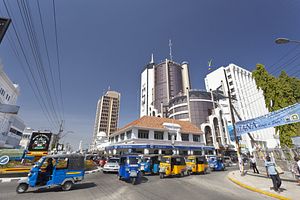On Sunday, a Chinese State Council official told a conference in Hainan that more than 50 countries are interested in participating in China’s Silk Road Economic Belt and Maritime Silk Road projects, jointly known as “one belt and one road.” “Along the belt and road are many developing countries with a combined population of 4.4 billion and an annual economic output of 2.2 trillion U.S. dollars,” Xinhua paraphrased the official as saying. In other words, China’s Silk Road is a big deal, and not just for Asia. In fact, the Silk Road is making progress on an entirely different continent – Africa.
During Foreign Minister Wang Yi’s trip to Africa in mid-January of this year, he visited Kenya and spoke about China’s plan to build a $3.8 billion railroad linking Nairobi, Kenya’s capital, to Mombasa, a port on the Indian Ocean. Though the railroad project isn’t being pitched as part of the Silk Road, it’s no coincidence that Nairobi, an inland city, is included on Xinhua’s Maritime Silk Road map. The rail link between Nairobi and Kenya’s largest port will be crucial in actually connecting Nairobi to the maritime trading route.
For now, Nairobi (presumably via Mombasa) is the only African city specifically marked on the map. But both Africa and China have far more ambitious dreams for upgrading African infrastructure. Speaking about the railroad project while in Kenya, Wang referenced a 2014 statement by Nkosazana Dlamini Zuma, the chair of the African Union Commission, in which Zuma spoke of a “a dream that one day the capitals of all African countries will be linked by high-speed railways.” Wang added, “As a good friend of Africa, China is willing to make efforts to help African friends realize the dream.” Building up that sort of infrastructure (which Wang called “a century project”) would potentially connect all of Africa to China’s Silk Road vision. The Kenya railroad project alone will eventually link Nairobi with the capitals of Uganda, Rwanda, Burundi, and South Sudan.
And Mombasa is not the only port China is developing on the African coast. China is also involved in developing ports in Djibouti, Tanzania, and Mozambique; it may also have plans to invest in ports in Madagascar and the Seychelles according to a Bloomberg report citing the Namibian Times. That would give China no less than six African ports on the Maritime Silk Road, ranging from the Indian Ocean through the Red Sea.
Brian Eyler, writing for East By Southeast, suggests that the Maritime Silk Road “is all about Africa.” Eyler argues that “in actuality the focus of the Maritime Silk Road is to support and facilitate booming trade growth between Asia and Africa.” Eyler further reports that China and Thailand recently agreed to create investment vehicles for developing 12 ports – including seven African ports (in Djibouti, Tanzania, Mozambique, Gabon, Ghana, Senegal, and Tunisia).
The Maritime Silk Road, like its overland counterpart, is currently in a stage that heavily emphasizes the building of infrastructure projects. That was China’s rationale for founding the Asian Infrastructure Improvement Bank in addition to a separate $40 billion Silk Road Fund. Both funding sources aim to “break the connectivity bottleneck,” in President Xi Jinping’s words.
China has long engaged in these sorts of infrastructure development projects in Africa, constructing roads, railways, and public buildings. While still rhetorically separate from the Maritime Silk Road, these projects speak to the same vision: regional connectivity, brought to you by Beijing. So while China publicizes its Silk Road progress in Asia, don’t forget that similar themes are unfolding in Africa — and that the two projects will eventually link up, if Beijing has its way.

































